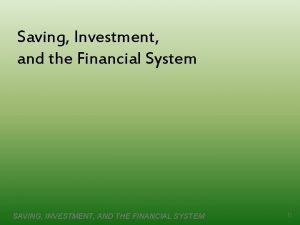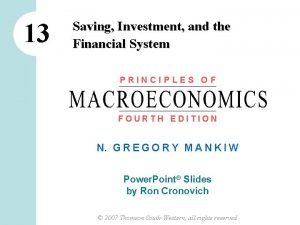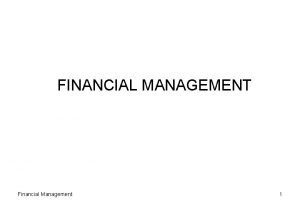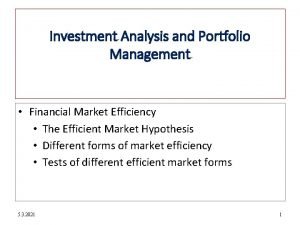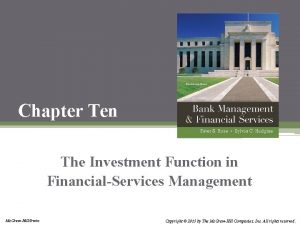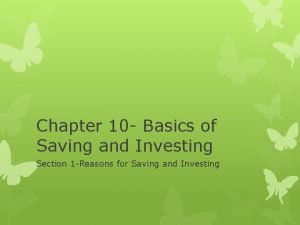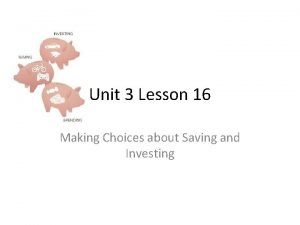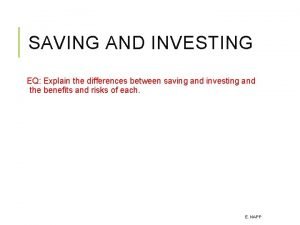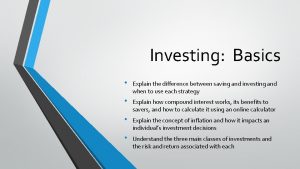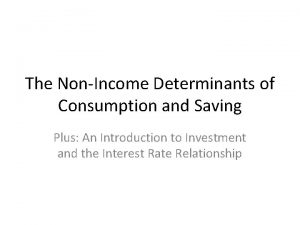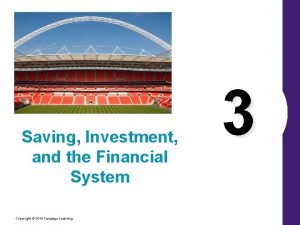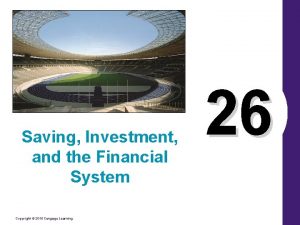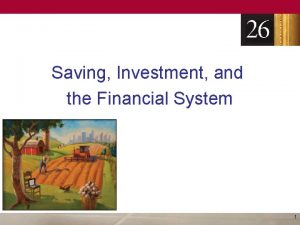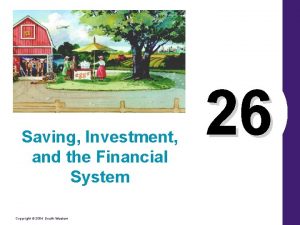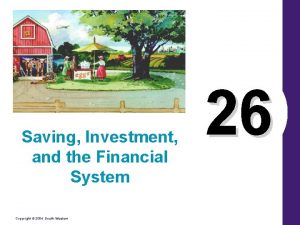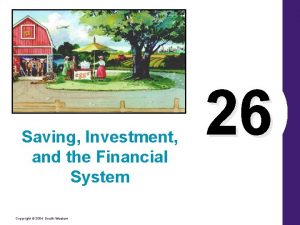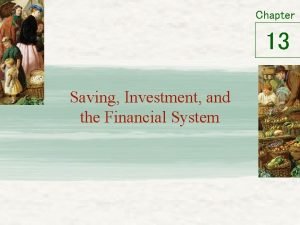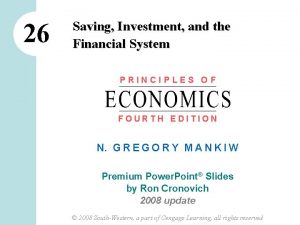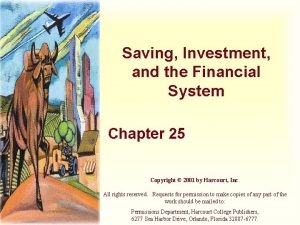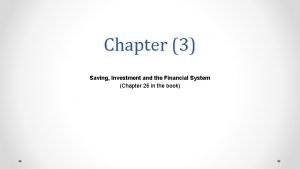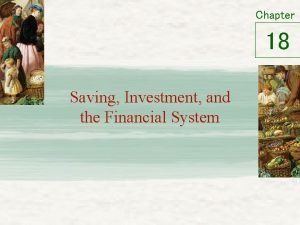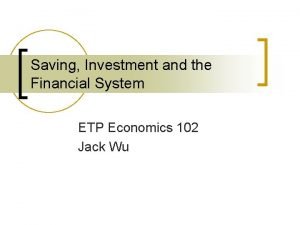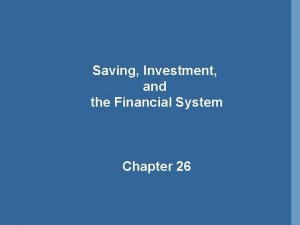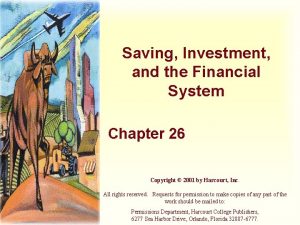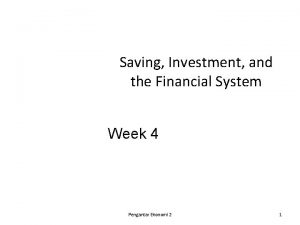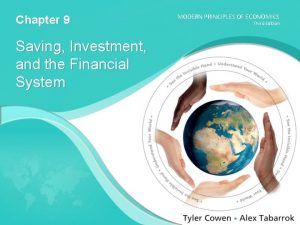Saving Investment and the Financial System Copyright 2010









































- Slides: 41

Saving, Investment, and the Financial System Copyright © 2010 Cengage Learning 3

Revision • What is the importance of capital investment on economy’s productivity? One way to raise future productivity is to invest more current resources in the production of capital. • How the increase in higher saving rate affects the productivity and income? An increase in the saving rate leads to rise in capital stock, higher level of productivity and income. • What about the effect on growth in the long run? Because of the diminishing returns the higher saving rate does not lead to higher growth in the long run. Copyright © 2010 Cengage Learning

Saving, Investment and the Financial System At any time some people want to save some of their income for the future, and others want to borrow in order to finance investments in new and growing businesses. Financial system is what brings these two groups of people together. Key issues concerning financial system are: • Which are the various institutions that make up the financial system? How do they function? • Which are the basic tools of finance? • How interest rate balances the supply and demand for loanable funds in financial markets? • How the government policies affect the interest rate and, thereby, society’s allocation of scarce resources? Copyright © 2010 Cengage Learning

The Financial System • The financial system consists of the group of institutions in the economy that help to match one person’s saving with another person’s investment. • It moves the economy’s scarce resources from savers to borrowers. Copyright © 2010 Cengage Learning

Financial Institutions in the Economy • Financial institutions can be grouped into two different categories: financial markets and financial intermediaries. • Financial Markets • Stock Market • Bond Market • Financial Intermediaries • Banks • Mutual Funds Copyright © 2010 Cengage Learning

Financial Markets • Financial markets are the institutions through which savers can directly provide funds to borrowers. • The Bond Market • A bond is a certificate of indebtedness that IOU specifies obligations of the borrower to the holder of the bond. • Characteristics of a Bond • Term: The length of time until the bond matures. • Credit Risk: The probability that the borrower will fail to pay some of the interest or principal. Copyright © 2010 Cengage Learning

Financial Markets • The Stock Market • Stock represents a claim to partial ownership in a firm and is therefore, a claim to the profits that the firm makes. • The sale of stock to raise money is called equity financing. • Compared to bonds, stocks offer both higher risk and potentially higher returns. • Stocks are traded on exchanges such as the London Stock Exchange and the Frankfurt Stock Exchange. Copyright © 2010 Cengage Learning

Financial Markets • The Stock Market • Most newspaper stock tables provide the following information: • • Price (of a share) Volume (number of shares sold) Dividend (profits paid to stockholders) Price-earnings ratio Copyright © 2010 Cengage Learning

Financial Intermediaries • Financial intermediaries are financial institutions through which savers can indirectly provide funds to borrowers. • Banks • take deposits from people who want to save and use the deposits to make loans to people who want to borrow. • pay depositors interest on their deposits and charge borrowers slightly higher interest on their loans. Copyright © 2010 Cengage Learning

Financial Intermediaries • Investment Funds • An investment fund is an institution that sells shares to the public and uses the proceeds to buy a portfolio, of various types of stocks, bonds, or both. • They allow people with small amounts of money to easily diversify. • Other Financial Institutions • • Credit unions Pension funds Insurance companies Loan sharks Copyright © 2010 Cengage Learning

The Basic Tools of Finance • Financial system coordinates the economy’s saving and investment – it concerns decisions we make today that will affect our lives in the future. BUT THE FUTURE IS UNKNOWN! • When a person decides to allocate some saving, or a firm decides to undertake an investment, the decision is based on a guess about the likely future result. BUT THE RESULT COULD END UP BEING VERY DIFFERENT! Copyright © 2010 Cengage Learning

The Basic Tools of Finance • In economics the uncertainty about future result of a current decision is called risk. • Finance is the field of economics that studies how people make decisions regarding the allocation of resources over time and the handling of risk. It deals with questions like: • How to compare sums of money at different points in time? • How to manage risk? • What determines the value of an asset (stock or bond)? Copyright © 2010 Cengage Learning

Future Value: Measuring the Time Value of Money • Receiving a given sum of money in the present is preferred to receiving the same sum in the future. • If r is the interest rate, then in N years an amount of Y today will have future value of: X=Y*(1 + r)N • The amount of money in the future that an amount of money today will yield, given prevailing interest rates, is called the future value. • According to the rule of 70, 70 if some variable grows at a rate of x percent per year, then that variable doubles in approximately 70/x years Copyright © 2010 Cengage Learning

Present Value: Measuring the Time Value of Money • Present value refers to the amount of money today that would be needed to produce, using prevailing interest rates, a given future amount of money. • In order to compare values at different points in time, compare their present values. • Firms undertake investment projects if the present value of the project exceeds the cost. • If r is the interest rate, then in N years an amount of Y today will have future value of: X=Y*(1 + r)N Copyright © 2010 Cengage Learning

Managing Risk • A person is said to be risk averse if she exhibits a dislike of uncertainty. • Individuals can reduce risk choosing any of the following: • Buy insurance • Diversify • Accept a lower return on their investments Copyright © 2010 Cengage Learning

Figure 1 Risk Aversion Utility gain from winning € 1, 000 Utility loss from losing € 1, 000 0 € 1, 000 loss Current wealth Wealth € 1, 000 gain Copyright © 2010 Cengage Learning Copyright© 2010 South-Western

The Markets for Insurance • One way to deal with risk is to buy insurance • The general feature of insurance contracts is that a person facing a risk pays a fee to an insurance company, which in return agrees to accept all or part of the risk. Copyright © 2010 Cengage Learning

Diversification of Idiosyncratic Risk • Diversification refers to the reduction of risk achieved by replacing a single risk with a large number of smaller unrelated risks. • Idiosyncratic risk is the risk that affects only a single person. The uncertainty associated with specific companies. • Aggregate risk is the risk that affects all economic actors at once, the uncertainty associated with the entire economy. • Diversification cannot remove aggregate risk. Copyright © 2010 Cengage Learning

Figure 2 Diversification Risk (standard deviation of portfolio return) (More risk) 49 Idiosyncratic risk 20 Aggregate risk (Less risk) 0 1 4 6 8 10 20 30 40 Number of Stocks in Portfolio Copyright © 2010 Cengage Learning Copyright© 2010 South-Western

Figure 3 The Trade-Off Between Risk and Return (percent per year) 8. 3 25% stocks 50% stocks 75% stocks 100% stocks No stocks 3. 1 0 5 10 15 20 Risk (standard deviation) Copyright © 2010 Cengage Learning Copyright© 2010 South-Western

Asset Valuation • Fundamental analysis is the study of a company’s accounting statements and future prospects to determine its value. • People can employ fundamental analysis to try to determine if a stock is undervalued, overvalued, or fairly valued. • The goal is to buy undervalued stock. Copyright © 2010 Cengage Learning

Efficient Markets Hypothesis • The efficient markets hypothesis is theory that asset prices reflect all publicly available information about the value of an asset. • A market is informationally efficient when it reflects all available information in a rational way. • If markets are efficient, the only thing an investor can do is buy a diversified portfolio Copyright © 2010 Cengage Learning

CASE STUDY: Random Walks and Index Funds • Random walk refers to the path of a variable whose changes are impossible to predict. • If markets are efficient, all stocks are fairly valued and no stock is more likely to appreciate than another. Thus stock prices follow a random walk. Copyright © 2010 Cengage Learning

Saving and Investment in the National Income Accounts • Recall that GDP is both total income in an economy and total expenditure on the economy’s output of goods and services: Y = C + I + G + NX • Assume a closed economy – one that does not engage in international trade (NX=0): Y=C+I+G • Now, subtract C and G from both sides of the equation: Y – C – G =I • The left side of the equation is the total income in the economy after paying for consumption and government purchases and is called national saving, or just saving (S). Copyright © 2010 Cengage Learning

Some Important Identities • Substituting S for Y - C - G, the equation can be written as: S=I • For the economy as a whole, saving must be equal to investment. • National saving, or saving, is equal to: S=I S=Y–C–G S = (Y – T – C) + (T – G) Copyright © 2010 Cengage Learning

The Meaning of Saving and Investment • National Saving • National saving is the total income in the economy that remains after paying for consumption and government purchases. • Private Saving • Private saving is the amount of income that households have left after paying their taxes and paying for their consumption. Private saving = (Y – T – C) • Public Saving • Public saving is the amount of tax revenue that the government has left after paying for its spending. Public saving = (T – G) Copyright © 2010 Cengage Learning

The Meaning of Saving and Investment • Surplus and Deficit • If T > G, the government runs a budget surplus because it receives more money than it spends. • The surplus of T - G represents public saving. • If G > T, the government runs a budget deficit because it spends more money than it receives in tax revenue. Copyright © 2010 Cengage Learning

The Market for Loanable Funds • Financial markets coordinate the economy’s saving and investment in the market for loanable funds. • The market for loanable funds is the market in which those who want to save supply funds and those who want to borrow to invest demand funds. • Loanable funds refer to all income that people have chosen to save and lend out, rather than use for their own consumption. Copyright © 2010 Cengage Learning

Supply and Demand for Loanable Funds • Financial markets work much like other markets in the economy. • The supply of loanable funds comes from people who have extra income they want to save and lend out. • The demand for loanable funds comes from households and firms that wish to borrow to make investments. • The interest rate is the price of the loan. It represents the amount that borrowers pay for loans and the amount that lenders receive on their saving. • The equilibrium of the supply and demand for loanable funds determines the real interest rate. • The interest rate in the market for loanable funds is the real interest rate. Copyright © 2010 Cengage Learning

Figure 1 The Market for Loanable Funds Interest Rate Supply 5% Demand 0 € 1, 200 Loanable Funds (in billions of euros) Copyright© 2010 South-Western

Supply and Demand for Loanable Funds • Government Policies That Affect Saving and Investment • Taxes and saving • Taxes and investment • Government budget deficits Copyright © 2010 Cengage Learning

Policy 1: Saving Incentives • Taxes on interest income substantially reduce the future payoff from current saving and, as a result, reduce the incentive to save. • A tax decrease increases the incentive for households to save at any given interest rate. • The supply of loanable funds curve shifts to the right. • The equilibrium interest rate decreases. • The quantity demanded for loanable funds increases. • If a change in tax law encourages greater saving, the result will be lower interest rates and greater investment. Copyright © 2010 Cengage Learning

Figure 2 An Increase in the Supply of Loanable Funds Interest Rate Supply, S 1 S 2 1. Tax incentives for saving increase the supply of loanable funds. . . 5% 4% 2. . which reduces the equilibrium interest rate. . . Demand 0 € 1, 200 € 1, 600 Loanable Funds (in billions of euros) 3. . and raises the equilibrium quantity of loanable funds. Copyright© 2010 South-Western

Policy 2: Investment Incentives • An investment tax credit increases the incentive to borrow. • Increases the demand for loanable funds. • Shifts the demand curve to the right. • Results in a higher interest rate and a greater quantity saved. • If a change in tax laws encourages greater investment, the result will be higher interest rates and greater saving. Copyright © 2010 Cengage Learning

Figure 3 An Increase in the Demand for Loanable Funds Interest Rate Supply 1. An investment tax credit increases the demand for loanable funds. . . 6% 5% 2. . which raises the equilibrium interest rate. . . 0 D 2 Demand, D 1 € 1, 200 € 1, 400 Loanable Funds (in billions of euros) 3. . and raises the equilibrium quantity of loanable funds. Copyright© 2010 South-Western

Policy 3: Government Budget Deficits and Surpluses • When the government spends more than it receives in tax revenues, the short fall is called the budget deficit. • The accumulation of past budget deficits is called the government debt. • A budget deficit decreases the supply of loanable funds. • Shifts the supply curve to the left. • Increases the equilibrium interest rate. • Reduces the equilibrium quantity of loanable funds. Copyright © 2010 Cengage Learning

Figure 4: The Effect of a Government Budget Deficit Interest Rate S 2 Supply, S 1 1. A budget deficit decreases the supply of loanable funds. . . 6% 5% 2. . which raises the equilibrium interest rate. . . Demand 0 € 800 € 1, 200 Loanable Funds (in billions of euros) 3. . and reduces the equilibrium quantity of loanable funds. Copyright© 2010 South-Western

Policy 3: Government Budget Deficits and Surpluses • Government borrowing to finance its budget deficit reduces the supply of loanable funds available to finance investment by households and firms. • This fall in investment is referred to as crowding out. • The deficit borrowing crowds out private borrowers who are trying to finance investments. • When government reduces national saving by running a deficit, the interest rate rises and investment falls. • A budget surplus increases the supply of loanable funds, reduces the interest rate, and stimulates investment. Copyright © 2010 Cengage Learning

Summary • The financial system is made up of financial institutions such as the bond market, the stock market, banks, and investment funds. • All these institutions act to direct the resources of households who want to save some of their income into the hands of households and firms who want to borrow. • Because savings can earn interest, a sum of money today is more valuable than the same sum of money in the future. • A person can compare sums from different times using the concept of present value. • Because of diminishing marginal utility, most people are risk averse. Copyright © 2010 Cengage Learning

Summary • The value of an asset, such as a share of stock, equals the present value of the cash flows the owner of the share will receive, including the stream of dividends and the final sale price. • According to the efficient markets hypothesis, financial markets process available information rationally, so a stock price always equals the best estimate of the value of the underlying business. • Some economists question the efficient markets hypothesis, however, and believe that irrational psychological factors also influence asset prices. Copyright © 2010 Cengage Learning

Summary • National income accounting identities reveal some important relationships among macroeconomic variables. • In particular, in a closed economy, national saving must equal investment. • The interest rate is determined by the supply and demand for loanable funds. • National saving equals private saving plus public saving. • A government budget deficit represents negative public saving and, therefore, reduces national saving and the supply of loanable funds. • When a government budget deficit crowds out investment, it reduces the growth of productivity and GDP. Copyright © 2010 Cengage Learning
 Mankiw chapter 26 solutions
Mankiw chapter 26 solutions Saving
Saving Saving investment and the financial system
Saving investment and the financial system Fixed investment and inventory investment
Fixed investment and inventory investment Copyright 2010 pearson education inc
Copyright 2010 pearson education inc C-929-a
C-929-a Variazioni finanziarie positive e negative
Variazioni finanziarie positive e negative Copyright 2010 pearson education inc
Copyright 2010 pearson education inc Copyright 2010 pearson education inc
Copyright 2010 pearson education inc Copyright 2010
Copyright 2010 Nwoz
Nwoz Copyright 2010 pearson education inc
Copyright 2010 pearson education inc Copyright 2010 pearson education inc
Copyright 2010 pearson education inc Copyright 2010 pearson education inc
Copyright 2010 pearson education inc 2010 pearson education inc
2010 pearson education inc Copyright 2010 pearson education inc
Copyright 2010 pearson education inc Composition copyright example
Composition copyright example Pearson education inc all rights reserved
Pearson education inc all rights reserved Fundamentals of analyzing real estate investments download
Fundamentals of analyzing real estate investments download Financial management theory
Financial management theory Financial investment analysis
Financial investment analysis Gold financial global investment
Gold financial global investment The investment function in financial services management
The investment function in financial services management Financial motivators
Financial motivators Lesson twelve saving and investing
Lesson twelve saving and investing 10 labour saving devices and their uses
10 labour saving devices and their uses Chapter 10 basics of saving and investing
Chapter 10 basics of saving and investing Chapter 10 basics of saving and investing
Chapter 10 basics of saving and investing The life-cycle model of consumption and saving
The life-cycle model of consumption and saving Lesson 16-2 saving and investing answer key
Lesson 16-2 saving and investing answer key Natural science grade 7 term 3
Natural science grade 7 term 3 Chapter 6 saving and investing
Chapter 6 saving and investing Explain the investment poem concerning stocks and bonds.
Explain the investment poem concerning stocks and bonds. Saving vs investing venn diagram answers
Saving vs investing venn diagram answers Determinants of consumption
Determinants of consumption Hình ảnh bộ gõ cơ thể búng tay
Hình ảnh bộ gõ cơ thể búng tay Lp html
Lp html Bổ thể
Bổ thể Tỉ lệ cơ thể trẻ em
Tỉ lệ cơ thể trẻ em Gấu đi như thế nào
Gấu đi như thế nào Tư thế worm breton là gì
Tư thế worm breton là gì Chúa yêu trần thế alleluia
Chúa yêu trần thế alleluia

